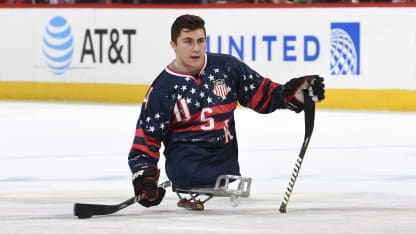Record 30 teams to compete in 2019 USA Hockey Sled Classic
Tournament presented by NHL brings together those with different backgrounds, skill levels

© Andy King/Getty Images
The 31-year-old U.S Army specialist lost both of his legs after his vehicle came under attack in Baghdad, Iraq, in March 2008. An avid hockey fan, Pierson said his first attempt at sled hockey was "horrible." But it was also motivating.
"I felt stupid the first time, so I had to come back out and try again," Pierson said at McFetridge Sports Center in Chicago, where the Tier I and IV teams practice on Wednesday and Sunday nights. "It's like your mind is thinking of what you have to do, and you know how to do it, but you can't do it. It's like you're trying to catch a ball, but your hands are taped up. But you just keep trying. It's all good, it's all fun."
The Blackhawks Tier I and Tier IV sled hockey teams have formed a tremendous bond and have enjoyed great success, and they're looking to repeat that when they play in the USA Hockey Sled Classic presented by the NHL at MB Ice Arena in Chicago from Feb. 7-10. The classic, which began in 2010 with four teams, will have a record 30 teams participating this year.

© Andy King/Getty Images
"It's super important to me and it's a testament to the growth of sled hockey as a sport across the country and Canada," USA Hockey Disabled Section chair J.J. O'Connor said. "Even more than that, it demonstrates that people with disabilities are fantastic athletes and compete just as hard as anyone who doesn't have a disability. Every person has disabilities, some are more visible than others. People who don't necessarily have one that's visible take for granted those who do, and don't realize they're people and competitive athletes like anyone else."
The Blackhawks Tier I and V teams won their respective divisions at the 2017 sled hockey classic in Minnesota in November of that year. The Tier I Blackhawks beat the Colorado Avalanche 7-1 and the Tier V team beat the Minnesota Wild. Thanks to their title win, the Tier V team moved up and will compete at Tier IV at this year's classic.
Jay French, who lives in Rosemont, Illinois, just northwest of Chicago, is in his fifth year with the Blackhawks. The 48-year-old, who joined sled hockey on the suggestion of a former fiancée, is excited to see how they do in Tier IV.
"It's little tougher competition, but a lot of the teams we're going to play in Division 4, we've played them previously," said French, who has spinal muscular atrophy Type III, a mild form of the disease characterized by muscle weakness and hypotonia resulting from the degeneration and the loss of lower motor neurons in the spinal cord and brain stem nuclei. "This is going to be tough competition about our skill level, but I feel pretty good that we can win again."
Sled hockey typifies the Hockey is for Everyone initiative. Players come from different backgrounds and deal with different disabilities, but they share common bonds in the desire to play and compete. Shirley Ryan AbilityLab Blackhawks coach Derek Daniels said he's often awestruck at what these athletes can do.
"You see the amount of effort and time they put into practice, from the Paralympians to the guys who have just started off and never play a sport again," Daniels said. "To glide on the ice, shoot the puck and check someone else, get physical, some of these guys, their faces light up. And you realize, providing the opportunity to display their ability through hockey, it's a fantastic outlet that a lot never saw in their future."
Kevin Hanusin of Valparaiso, Indiana, hadn't played team sports in the past but got interested in sled hockey when he saw a sled-hockey sticker on a friend's van four years ago. Hanusin, who has had a spina bifida condition since birth, played with a team in South Bend, Ind., for one year before joining Chicago's team.
"I've always liked hockey, I've always liked the Blackhawks. So, to be able to play my favorite sport was pretty awesome," said Hanusin, 47. "This sport is physically demanding, and this sport is not holding back. It's full contact, it's full skating. It's not easy, but I like the challenge."
It's definitely that. Players use adaptive sleds with two skate blades on the bottom. They also use shortened sticks with blades on one end to handle the puck and picks on the other end to push the sled around the ice. The sled blades are adjustable; the wider the blades are, the easier it is to keep your balance. Elite players can have the blades as close as an inch apart.
"The tighter you have it, the harder it is to stay up, but you get better turns out of it," Hanusin said.
Brody Roybal makes the turns look easy. A sled hockey player since he was 7 years old, he makes a lot of aspects of the game look easy. Born without femurs in either leg, the 20-year-old is a congenital bilateral amputee. At 12, he joined the adult league. At 15 Roybal became the youngest member of the 2014 U.S. Paralympic sled hockey team, which won gold that year and again in 2018.

© Bill Smith/Getty Images
"It's given me everything," Roybal said of sled hockey. "I've been able to travel all over the world with the national team, I travel around the country with these guys. I mean, there are endless opportunities outside of playing hockey; the travel, sponsorship opportunities, a job. It's grown so much since I started."
There's a wide range of experience on the teams. Some have been playing for more than 10 years while others have joined recently. Ty Johnson started playing sled hockey with the Blackhawks nine months ago. The 32-year-old Chicago native, who lost his right leg in a motorcycle accident on May 30, 2017, played baseball and football when he was younger. He said he was "humbled" when he first tried hockey.
"It was tough for me to stay upright," he said. "Then you're learning how to turn and move forward. Once you learn how you turn, there's a puck coming your way, and you've got to learn how to stop that. Then you've got to learn how to shoot it, then other people are chasing you trying to stop you for doing what you want to do. It was very humbling. It was tough, challenging experience, but I loved it."
The competition is strong but so are the bonds. They understand what each other is going through. Johnson called the group, "a band of misfit toys."
"Everybody here has some type of disability, and it's rare you meet people with disabilities unless you have one," Johnson said. "But we're just pretty normal, too. We want to enjoy our lives to the best of our abilities."
Travis Dodson lost his left leg at the hip and right leg below the knee when he was struck by a grenade on Feb. 14, 2007, in Iraq. Dodson, who has played with the Blackhawks for four years, was interested in joining a team after participating in individual sports previously. The tight-knit aspect of the group is also appealing.
"I think we all have a general understanding of what each other is going through," Dodson, 33, said. "Some talk about whatever problem there is and we all can relate, where maybe other people couldn't. So, there's definitely that factor."
The Chicago sled hockey teams are looking to repeat their success from the 2017 Classic. Whether or not that happens, the happiness and friendships sled hockey has given them are immeasurable.
"I would say it's almost like the military, you know? It's a second family," Pierson said. "You're with them twice a week, two or three hours every practice and then for trips, three or four days straight. You get to know everybody, their background, you get to meet their families, you learn to bond together. It's great."

















